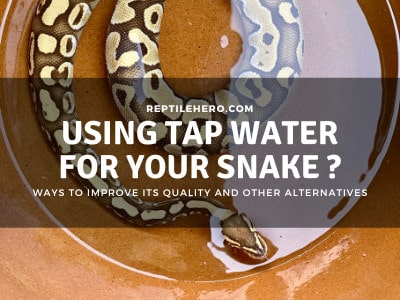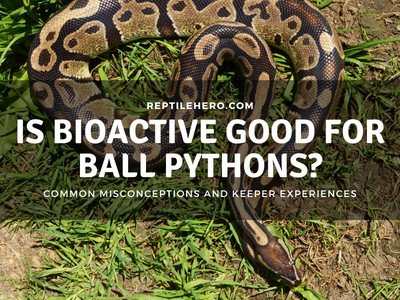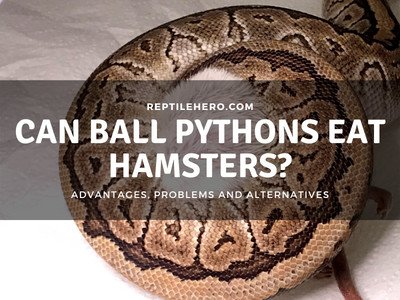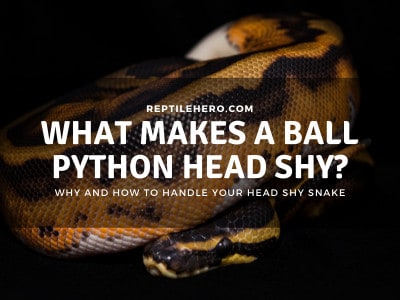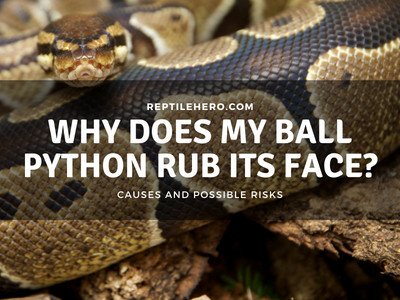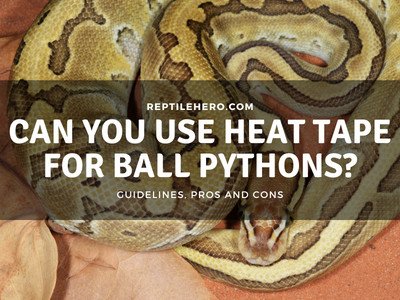Can Ball Pythons Eat Something Big? (Are There Harmful Effects?)
Ball pythons can eat prey that is larger than their head, but how big of a feeder can they take? Can they eat something half their size? Or should they only be given small prey? Do big meals come with big risks for our lovely pythons?
In general, ball pythons can safely eat big prey as long as it is no larger than 1.5 times the width of their midsection. Because of their mandible’s structure, they can naturally eat prey larger than that but doing so comes with several risks. These include fasting, obesity, regurgitation, and constipation.
Ball pythons are creatures adapted to swallow their prey whole. But when is prey too big for them and what is the “right” size? Is feeding a large meal bad for them? Find out more as you read below!
Is There a Tool Large Feeder For Ball Pythons?
On average, adult ball pythons can eat feeders as large as a medium-sized rat (150g). In rare circumstances, however, there are large specimens that can take on much bigger rats (300-500g).
In the wild, ball pythons typically prey on small to medium-sized rodents like mice, rats, shrews, etc. They are opportunistic hunters and will prey on anything that they think could be taken down.
Ball pythons are equipped with mandibles that can spread apart which increases the width of their mouth [1]. This evolution allows prey, bigger than the size of their head, to get swallowed after the constriction.
Though there are no reports of adult ball pythons eating prey that are half their weight, it might be possible due to their opportunistic nature. Even if a large prey can harm them, they could still attempt to eat it.
Imagine if you only encounter food once every month or so. I am sure you will take it even if it is too big for you. This analogy greatly relates to how ball pythons are in the wild.
In captivity, we are optimizing their care, and feeding them the right-sized feeder can keep them healthy which can prolong their life.
Effects of Feeding Large Feeders to a Ball Python (4 Problems!)
As a general rule, feeders weighing 200 grams and above may be too big for most adult ball pythons.
Some effects of feeding large prey are: 1) fasting, 2) obesity, 3) regurgitation, and 4) constipation.
1. Fasting
Most of the time, ball pythons that have consumed large prey in a short amount of time will fast for long periods. Some ball pythons that are fed large meals weekly, can go without feeding for 1-2 months or even longer.
Ball pythons typically need at least 2-3 days of rest after fully digesting their meal because of how strenuous the process is to their system [2].
Due to this, some may change their feeding schedules when they are first fed a larger feeder.
For example, a ball python that is fed 50grams of rat per week can go off-feed for 2 weeks or more if it’s suddenly fed a 70-100 gram rat.
There are also reports of ball pythons fasting for several months after being overfed for just a month.
2. Obesity
In general, ball pythons that are fed large meals consistently can become overweight or obese due to excessive amounts of fat. This can shorten their lifespan and lead to unhealthy conditions like fatty liver and heart disease.
Fatty liver disease in ball pythons is caused by the fat build-up around the liver, which metabolizes the fat and protein while also producing uric acid [3].
Some signs of an unhealthy liver in pythons are the consistency of yellow-green urates, lethargy, and watery stool.
I recommend feeding the right feeder size rather than giving your ball python a meal that is too large for them. They can take a meal twice the width of their body. But it is unhealthy for them, especially if done frequently.
Ball pythons kept in captivity are more sedentary compared to those in the wild which have the option of roaming around vast spaces. That is why overfeeding them can cause unhealthy conditions.
3. Regurgitation
As a whole, the digestion process of ball pythons causes them to be reclusive and feel vulnerable during the process. If they feel threatened or stressed, especially when feeding on very big prey, they may regurgitate their meal as a response.
When ball pythons regurgitate, they could seriously damage their esophagus. Worst-case scenario, they could even die in the process!
Another common cause of vomiting in ball pythons is if a prey takes too long to get digested. If your ball python vomited, I highly suggest taking it to a veterinary doctor.
Then, after regurgitation, I suggest letting your ball python rest for at least 2 whole weeks, before offering a moderately sized meal. This is to avoid shocking their digestive system.
Can a ball python choke while swallowing prey?

A ball python cannot choke while swallowing its prey because they use a breathing organ called the glottis trachea. However, if they regurgitated a large meal like an adult rat, they can get suffocated from the digestive fluids being released along the partially consumed prey.
4. Constipation
On average, ball pythons that are fed a large meal weekly, have a high chance of being constipated. Snake constipation can be caused by overfeeding and low temperatures/humidity.
To determine whether or not a ball python is constipated, I suggest looking at its rectum. If you see a big lump, most of the time it will be a build-up of their feces.
As a first aid measure, I suggest giving constipated ball pythons a 10-15 minute lukewarm bath (82-85F) for 3 consecutive days or less.
If it is still constipated after all that time, wait for another 3 days and if there are no feces yet then I suggest going to a veterinarian.
2 Things to Remember When a Ball Python Ate a Large Meal
In total there are 2 things to remember when a ball python has eaten a large meal: 1) no handling and 2) daily checking.
1) No Handling
As a general rule, newly-fed ball pythons should not be handled for at least 24 hours. For ball pythons who ate a large meal, it is recommended to refrain from handling for a week.
Ball pythons that have eaten a large prey have a higher risk of regurgitation when handled after eating.
I suggest leaving it alone for a week to make sure that the meal is fully digested.
I also recommend that they be provided with a hiding place to decrease the chance of them getting stressed which can also cause them to vomit.
2) Daily Checking
There are 3 things to check daily if your ball python has eaten a large meal: temperature, humidity, and waste. These factors can lessen the risks of regurgitation for a newly-fed ball python.
1. Temperature
For newly-fed ball pythons, the temperature is the most crucial aspect to aid in the digestion of their meal. When a ball python has consumed a large meal it is recommended to keep the heat source above or under the location of the hide.
I recommend maintaining temperatures ranging from 88-92°F on the hot side and around 76-80°F on the cold side after eating large prey. This supplemental heat can allow your ball python to utilize it 24/7 especially when digesting a large prey.
For daytime, you can use a heat bulb. But for the nighttime, If your ambient room temperatures drop to 70F and below I recommend using a lightless heating device for the hot side of the enclosure.
>> Learn more about heat lamps in our article can ball pythons see red light?
2. Humidity
One of the most important things to provide for a newly eaten ball python is humidity. Providing a water dish can increase humidity and lessen ball pythons’ dehydration risk.
Maintaining the humidity level of 60-80% can also improve the ambient temperature whilst decreasing the chance of constipation for the ball python.
>> Learn more about keeping humidity levels properly in our article about foggers and misters for ball pythons
3. Waste
Checking whether there is any waste in their tank or not is essential in making sure a ball python does not get sick from eating a large meal. Wastes like regurgitated food and vomit must always be monitored and removed immediately.
Are regurgitated food and vomit the same?
Regurgitated food has a very putrid smell and can also be a breeding ground for bacteria which can cause scale rot and other diseases. Vomit often happens during the end of the digestion period which is mostly on day 4 or 5 after feeding.
A vomiting ball python may imply that the food is not digested properly inside it and can cause inflammations and death when left untreated.
What is the Right Feeder Size for a Ball Python
On average, feeders must be around 10-15% the weight of a ball python. The maximum size of a feeder must be 1.5 times the width of the largest part of the ball python to avoid feeding a prey that is too large.
| Ball Python Weight (Grams) | Prey Size (Grams) | Feeding Frequency |
| 50-100 | 1 hopper mouse(8-10g) or rat fuzzy(8-12g) | Once every 5-7 days |
| 100-350 | 1 small adult mouse (12-18g) or rat pup(20-30g) | Once every 7 days |
| 350-500 | 1 jumbo mouse(30-50g) or juvenile rat (30-40g) | Once every 7 days |
| 500-900 | 2 jumbo mice(66-100g) or small adult rat (50-90g) | Once every 9-12 days |
| 900-1500 | 2 jumbo mice (80-130g) or small adult rat (70-120g) | Once every 14-21 days |
| Above 1500 | 2 jumbo mice (90-150g) or medium adult rat (90-150g) | Twice or once every 30 days |
To avoid the risk of regurgitation, I recommend gradually increasing the size of the feeder in relation to the weight of the ball python. Although the recommended ratio (10-15%) will not be applicable to ball pythons weighing 2000 grams or more.
For ball pythons below 2 years old, the 13-15% feeder weight can be utilized. Conversely, for ball pythons 2 years and above I recommend following the 10-12% until the feeder size reaches 150g.
The prey ratio decreases because older snakes tend to have a slower metabolism as compared to younger ones.
For ball pythons weighing 2,000 grams and above, I suggest feeding them prey with a maximum weight of 200 grams as it will still suffice for a big ball python while decreasing the chance of obesity.
>> Learn more about feeder rodents in our article about feeding rats and mice to ball pythons.
Further Questions
How do ball pythons adjust to prey that gets stuck?
Ball pythons, like most snakes, have a separated lower jaw which allows them to swallow prey larger than the size of their head. They also have an organ called glottis trachea and it allows them to get some air while swallowing their food whole.
Do ball pythons struggle to eat?
In general, ball pythons will not struggle because they would not kill what they cannot eat. This means that they can generally gauge whether or not they can take on a certain prey when they are hunting.
Can ball pythons choke on prey that is either small or big?
Ball pythons cannot choke when taking in prey, even if its size is the most they can take. However, ball pythons can suffocate when regurgitating food which is caused by the digestive fluids that come with the regurgitated prey.
What to do if a ball python cannot swallow prey?
When a ball python cannot swallow prey, it is recommended to remove and throw out the discarded feeder to prevent it from rotting inside the enclosure. This will prevent bacterial growth and putrid smell near the vicinity of the ball python.
Summary of Can Ball Pythons Eat Big Prey?
On average, adult ball pythons can eat feeders as large as a medium-sized rat (150g). In rare circumstances, however, there are large specimens that can take on a large rat (300-500g).
As a general rule, feeders weighing 200 grams and above may be too big for most adult ball pythons. Some effects of feeding large prey are fasting, obesity, regurgitation, and constipation.
The recommended feeder weight is around 10-15% of the weight of a ball python. Additionally, the maximum size of a feeder must be 1.5 times the width of the largest part of the snake.

